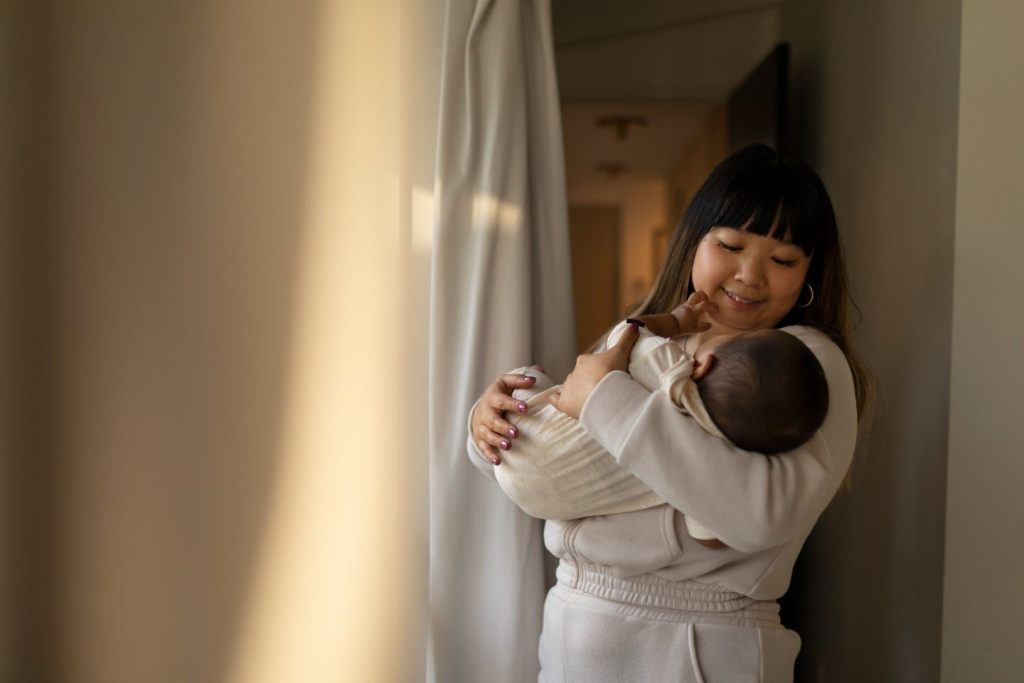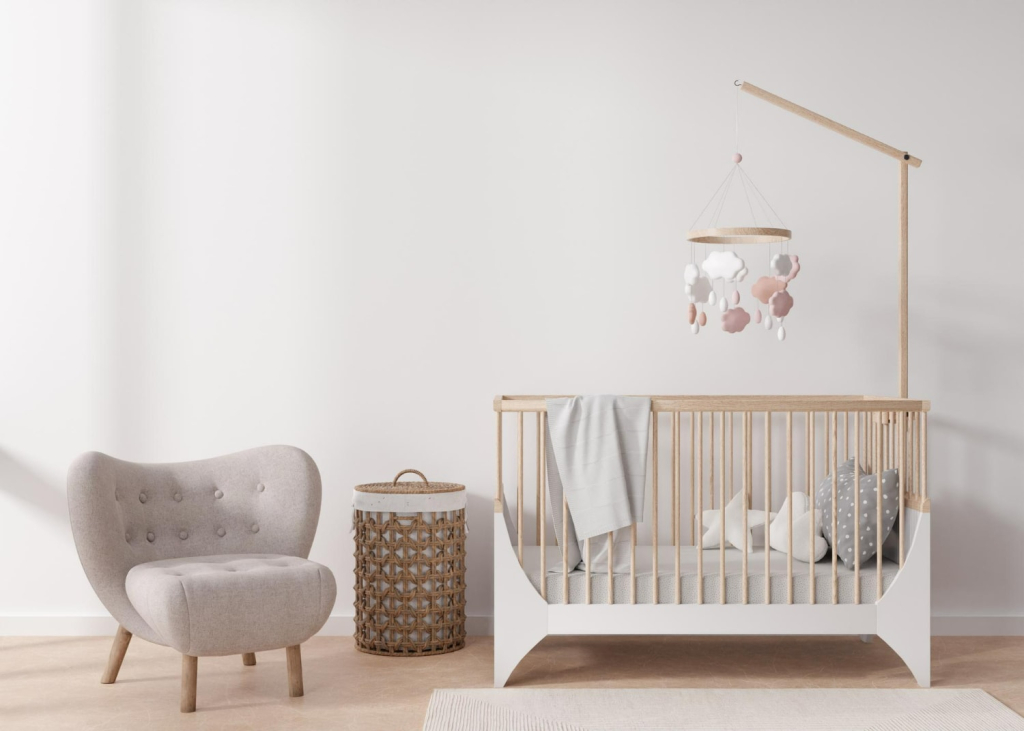
Image source: Freepik
Bringing a newborn home is one of the most beautiful and transformative experiences for any Filipino family. The quiet hum of a new baby’s first breaths, the soft rhythm of feeding, and the sleepless nights filled with lullabies mark the beginning of a new life. But new mothers should expect the first few weeks after birth can also be overwhelming, especially for a those still recovering from delivery. Navigating this period requires compassion, structure, and an environment that supports both mother and child.
This guide explores how to build a nurturing space for newborn and mom care at home, blending practical advice, emotional insight, and cultural relevance for Filipino families. It draws on expert health guidance, real-life parenting experience, and home design ideas suited to our climate and lifestyle.
The First Gentle Days as New Parents
New parents often feel a surge of joy that coexists with the challenges of sleepless nights, feeding schedules, and the physical recovery that follows pregnancy and delivery. During this sensitive phase, a mother’s body is healing as she learns the rhythm of caring for a newborn, especially if it’s the first baby in the family.
Filipino families, known for their close ties, play a vital role during this time. A supportive family member or partner can help the new mother adjust to feeding, sleep, and emotional shifts. Creating an atmosphere of rest, warmth, and reassurance is just as essential as meeting the baby’s basic needs.
Preparing the Space for Newborn Baby Care
The physical environment plays a powerful role in shaping comfort and safety for both baby and parents. Start by choosing a calm room close to the master bedroom. Many experts recommend that the infant sleep in the same room as the parents but not in the same bed, to lower the risk of sudden infant death syndrome.
A sturdy crib mattress and breathable blanket will keep the baby warm without overheating. The crib should be free of soft toys or loose clothes that could obstruct the baby’s face. If possible, position the crib near a window for natural light, but ensure direct sun exposure is controlled with curtains.

Design a small nursing nook where the new mother can sit comfortably during night feedings. Add a side table with essentials—milk bottles, water, a small lamp, and healthy food or snacks—to support her recovery. Gentle lighting, pastel wall colors, and good air flow all contribute to keeping both baby and mother calm and well-rested.
Creating a Routine for Rest and Recovery
Most babies sleep in short bursts throughout the day and night, requiring patience and flexibility. Encourage parents to take turns staying awake so each can get rest. A simple system—like alternating naps—can ease fatigue.
Beyond sleep, the new mother needs good nutrition and a balanced diet to support healing and breastfeeding. Simple, nourishing Filipino meals like tinola with malunggay, oatmeal with fruit, or fresh fish soup provide warmth and nutrition without being too heavy. For new mothers, good nutrition is essential. A balanced diet rich in vegetables, protein, and fluids supports milk production and recovery. Family members and other adults can help by cooking, preparing snacks, or encouraging the mother to eat regularly—even when tired.
When challenges arise such as painful feeding, persistent crying, or discomfort, it’s best to talk to a doctor or lactation consultant. Their advice helps prevent small concerns from becoming serious health risk factors later on.
Understanding and Preventing Sudden Infant Death Syndrome
As joyful as parenthood is, it also comes with worries, especially for new parents learning about safety. Sudden infant death syndrome (SIDS) remains one of the most feared topics in early newborn care, but awareness and prevention go a long way toward protecting most babies.
SIDS occurs when a newborn baby unexpectedly dies during sleep with no clear medical cause. In the Philippines, health professionals stress that safety practices at home can reduce this tragedy dramatically.

Safe Sleep Practices for Every Family
To minimize SIDS risk, always place the baby on their back during sleep time. Avoid soft bedding or pillows under the baby’s head, and ensure the crib mattress is firm and fitted. The room should be comfortably cool to keep the baby warm without overheating.
During home visits, midwives and health facility staff often remind caregivers to check the baby’s face for any obstruction and ensure the blanket or clothes don’t cover their airways. Cleanliness matters too: keeping the baby clean, changing clothes regularly, and washing bedding prevents rashes or respiratory irritation.
A Guide to Newborn Feeding for Nourishing Beginnings
Few things strengthen the bond between mother and child like feeding. For the new mother, this time is both tender and challenging. She may still be recovering from delivery, yet her body begins producing milk to sustain her newborn.
Feeding With Love and Patience
Most babies feed every two to three hours, often waking during the night. Their crying is a signal—they might be hungry, wet, cold, or simply craving closeness. Over time, parents learn to interpret these signs naturally.
Milk Alternatives
When breastfeeding isn’t possible, safe milk alternatives can be introduced under a doctor’s guidance. What matters most is that the baby feels secure and cared for during feeding. Maintaining a consistent routine builds trust and soothes both mother and child.
During these moments, eye contact and gentle talk nurture emotional bonds. Every feeding is an opportunity to connect and strengthen attachment—a foundation that shapes the baby’s life far beyond infancy.

Recognizing Danger Signs
Even with diligent care, newborns and new mothers can face health challenges. Recognizing danger signs early prevents complications and ensures both recover well.
For the Newborn Baby
In the first few days, new parents should be observant. If the baby has a fever, difficulty feeding, persistent crying, or irregular breathing, these are possible signs of illness. The umbilical cord should stay clean and dry until it falls off naturally. Any redness, swelling, or foul smell means it’s time to visit a health facility immediately.
The first bath should be delayed until the baby’s body temperature stabilizes, usually after the first few days. Until then, gentle wiping with warm water keeps the baby clean without overcooling their skin.
For the New Mother
For women recovering from delivery, the body undergoes immense changes. Light bleeding is normal, but heavy flow or large clots are danger signs that require urgent doctor attention. Other warning signs include persistent fever, pain, or feelings of sadness that persist beyond two weeks.
Emotional health matters. Postpartum depression can affect any new mother, regardless of background. Family and friends should talk openly, provide support, and encourage rest. Home interventions—like ensuring good nutrition, reducing chores, and regular naps—help reduce stress.
If medical care is needed, make sure access to a nearby health facility is convenient. Quick response can make a significant difference in recovery and safety.

Taking Care of the Family Beyond the First Few Weeks of Life
After the first few weeks, life slowly finds rhythm. New parents begin understanding their baby’s patterns, and mothers start feeling more like themselves again. Yet taking care of the family remains a shared effort.
Encourage shared routines where the partner, grandparents, or older siblings help with feeding, diaper changes, or naps. These small acts build connection and prevent burnout.
Designing a Nurturing Home for Long-Term Wellbeing
Home design can play a vital role in sustaining a calm, healthy lifestyle. In a community like Camella Dos Rios in Cabuyao, Laguna, new parents benefit from a safe, family-friendly environment surrounded by green spaces and quiet streets—ideal for spending time outdoors with a newborn. The location’s proximity to hospitals such as Calamba Medical Center, just a 15-minute drive away, also gives families peace of mind knowing quality healthcare is within reach.
Inside the home, thoughtful layout and design enhance comfort and functionality. Consider these small but meaningful details:
- Create a flexible corner near the master bedroom where the baby can nap during the day, allowing the mother to rest nearby.
- Set aside a quiet nook with a comfortable chair for feeding or nursing, complete with soft blankets and calming colors.
- Use gentle, natural lighting to support sleep time and emotional wellbeing.
- Keep air circulation steady to prevent overheating and maintain a warm but fresh atmosphere. This also keeps the baby and the new mom from inhaling any form of smoke that can pose dangers to both of them.
- Choose non-toxic paints, easy-to-clean materials, and slip-free flooring to ensure safety.
These shared moments outside, combined with home comfort, contribute to emotional healing and stronger family bonds.
Conclusion
The early months of newborn and mom care at home are a time of deep change and learning. Each feeding, sleep, and crying spell becomes part of a family’s rhythm. A new mother needs understanding, good nutrition, and space to heal.
A newborn baby needs love, warmth, and safety. Together, they thrive best in a home built on care, support, and thoughtful design.
Motherhood, after all, is not a solo journey. With family, friends, and a supportive community, treat the home as a sanctuary where life, in all its tender beginnings, unfolds with grace and hope.


